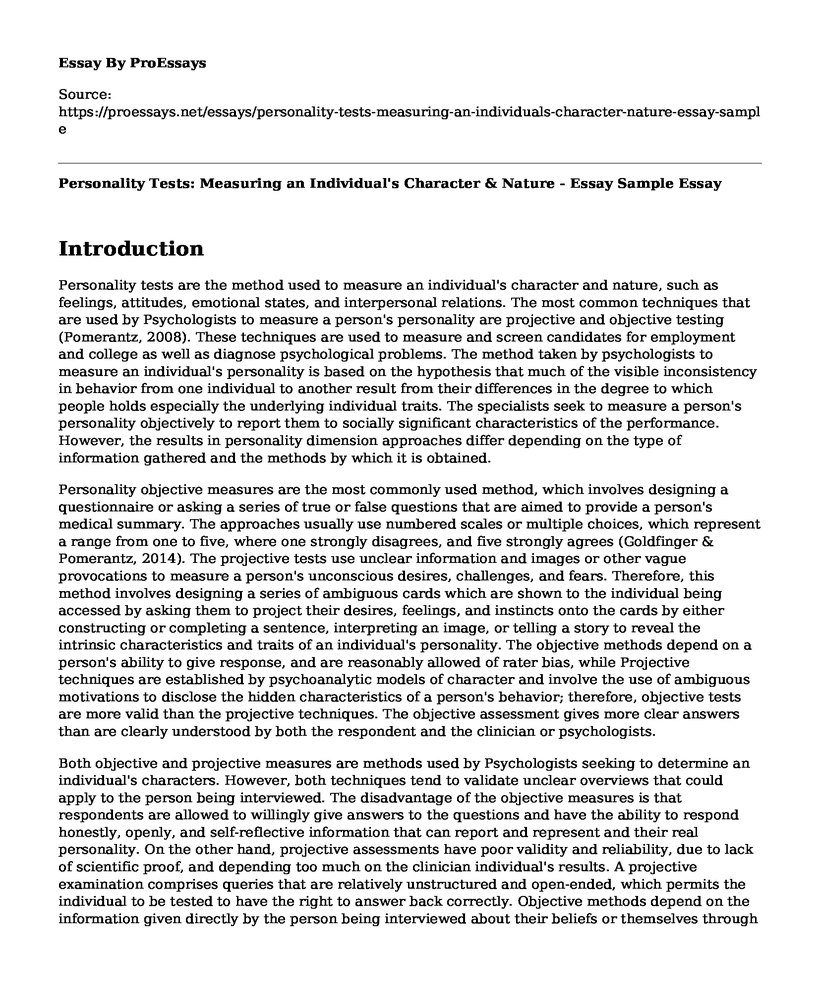Introduction
Personality tests are the method used to measure an individual's character and nature, such as feelings, attitudes, emotional states, and interpersonal relations. The most common techniques that are used by Psychologists to measure a person's personality are projective and objective testing (Pomerantz, 2008). These techniques are used to measure and screen candidates for employment and college as well as diagnose psychological problems. The method taken by psychologists to measure an individual's personality is based on the hypothesis that much of the visible inconsistency in behavior from one individual to another result from their differences in the degree to which people holds especially the underlying individual traits. The specialists seek to measure a person's personality objectively to report them to socially significant characteristics of the performance. However, the results in personality dimension approaches differ depending on the type of information gathered and the methods by which it is obtained.
Personality objective measures are the most commonly used method, which involves designing a questionnaire or asking a series of true or false questions that are aimed to provide a person's medical summary. The approaches usually use numbered scales or multiple choices, which represent a range from one to five, where one strongly disagrees, and five strongly agrees (Goldfinger & Pomerantz, 2014). The projective tests use unclear information and images or other vague provocations to measure a person's unconscious desires, challenges, and fears. Therefore, this method involves designing a series of ambiguous cards which are shown to the individual being accessed by asking them to project their desires, feelings, and instincts onto the cards by either constructing or completing a sentence, interpreting an image, or telling a story to reveal the intrinsic characteristics and traits of an individual's personality. The objective methods depend on a person's ability to give response, and are reasonably allowed of rater bias, while Projective techniques are established by psychoanalytic models of character and involve the use of ambiguous motivations to disclose the hidden characteristics of a person's behavior; therefore, objective tests are more valid than the projective techniques. The objective assessment gives more clear answers than are clearly understood by both the respondent and the clinician or psychologists.
Both objective and projective measures are methods used by Psychologists seeking to determine an individual's characters. However, both techniques tend to validate unclear overviews that could apply to the person being interviewed. The disadvantage of the objective measures is that respondents are allowed to willingly give answers to the questions and have the ability to respond honestly, openly, and self-reflective information that can report and represent and their real personality. On the other hand, projective assessments have poor validity and reliability, due to lack of scientific proof, and depending too much on the clinician individual's results. A projective examination comprises queries that are relatively unstructured and open-ended, which permits the individual to be tested to have the right to answer back correctly. Objective methods depend on the information given directly by the person being interviewed about their beliefs or themselves through questions and answer design. Unlike objective measures where clinicians can fake and guess a person's character, projective tests are not transparent, and psychologists cannot figure out how an individual's responses will be interpreted (Dean & Noggle, 2013). Therefore, subjects cannot easily fake personality traits on a projective test; therefore, clinicians and researchers prefer using projective methods since they mostly give factual, accurate, and useful information.
References
Dean, R. S., & Noggle, C. A. (2013). The Neuropsychology of Psychopathology. Available form: New York, Springer Pub. Co.Goldfinger, K., & Pomerantz, A. M. (2014). Psychological Assessment and Report Writing. Available from:Thousand Oaks, California, SAGE.
Pomerantz, A. M. (2008). Clinical Psychology: Science, Practice, and Culture. Available from: Los Angeles, Sage Publications.
Cite this page
Personality Tests: Measuring an Individual's Character & Nature - Essay Sample. (2023, May 03). Retrieved from https://proessays.net/essays/personality-tests-measuring-an-individuals-character-nature-essay-sample
If you are the original author of this essay and no longer wish to have it published on the ProEssays website, please click below to request its removal:
- The Reason Why People Change their Behavior - Paper Example
- Is It Morally Permissible for Physicians to Assist in a Suicide? Essay
- Self-Reflection: Motivation Paper Example
- Essay Sample on Occupational Therapy: Professional Qualifications to Enhance Recovery
- Financial Stress and Domestic Violence: The Startling Link - Essay Sample
- Paper on School-Aged Children's Emotional and Physical Needs: Safety, Security, and Care
- Essay An Intervention Helpful for Group Process







